Spider Silk 101: What’s It Made Of And How Strong Is It?
Spider silk is one of the 7 great wonders of the animal kingdom.
That a small animal, often less than a millimeter across, can make a substance that we humans with all our technology is unable to reproduce (a substance that is tough, stronger and more flexible than anything else we can make), is surely a humble reminder of the fact that nature created us and not the other way around.
One of the most astounding things about spiders is their ability to make silk. Their webs amaze and fascinate us and have been used by us in many cultures throughout history.
All spiders possess spinning glands and make silk. They use it for a safety dragline, to fly, for making a highly durable cocoon for their eggs, to line their homes, to trap their prey and to immobilise their victims.
In some species, males use silk to ritually immobilize the females before mating; and all male spiders make a special sperm-web or sperm-line, to allow them to transfer the sperm from their genitals to their copulatory organs. Not all species use silk for all these reasons, but all species make egg cocoons.
Among the most amazing and commonly admired Spider Webs, are the various Orb Webs. The largest Orb Webs in the world are spun by Caerostris darwini in Madagascar, which may be 2.8 metres in diametre and are capable of catching small birds and bats.
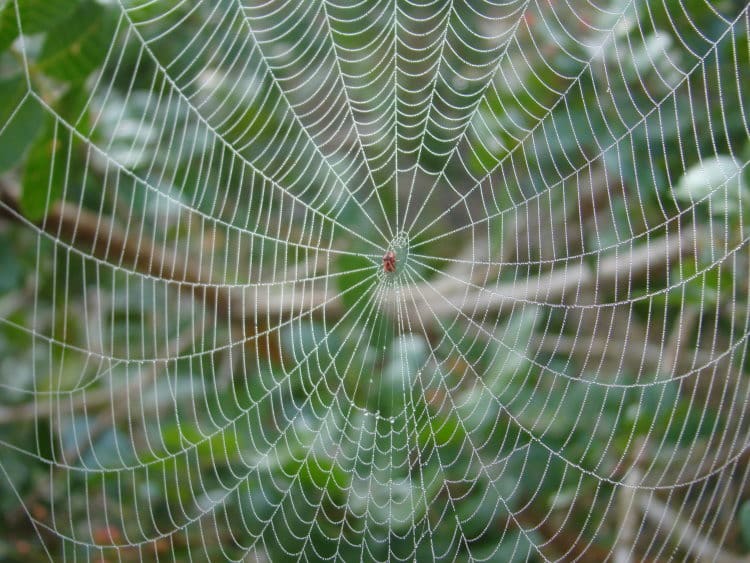
G. F. Masterman – once the British Ambassador to Paraguay – described social spiders in Paraguay building webs 9 metres (30 ft) long in his book Seven Eventful Years in Paraguay (1888). Whatever the truth here, it is a fact that there are billions of kilometres of spider silk spread across the globe and it is all amazing.
You can use these links to skip to the relevant part of this page:
Spiders can produce different kinds of silks, at least 7 or 8 different kinds. However, generally individual spider species use 5 to 6 types or less – in other words not all spiders produce all the possible types of silk.
When assessing the strength of spider silk, scientists usually refer to dragline silk. It is also generally accepted that spiders in the genus Nephila produce the strongest draglines, however this may reflect their large size.
And spider silk is both light and strong. Hillyard says:
“A typical strand of garden spider silk has a diametre of about 0.003 mm (0.00012 in); compare this with silkworm silk which is 0.03 mm in diametre, or ten times as thick”
Knowing all this, we should first accept that any measurements we come across on the strength of spider silk will not apply to all the silks produced by one spider (and definitely not to the silk of all spiders). The data we do have applies to the toughest spider silk we know of – just how much variation there is between different silks and species I have not been able to find out.
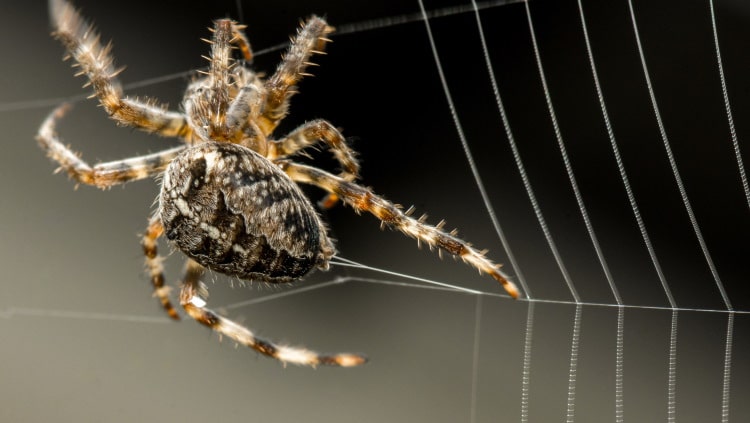
Nevertheless, the strength and resilience of spider silk has amazed people for thousands of years.
Reading around, on and off the web, we get a lot of facts about the strength of spider silk that sometimes seem contradictory… although they all agree that spider silk is way stronger than any other silk or natural material. Here are a few quotes and examples:
Paul Hillyard says in The Book of the Spider 1994:
“For an equal diametre, spider silk is stronger than steel and about as strong as nylon. It is, however much more resilient and can stretch several times before breaking – it is twice as elastic as nylon and more difficult to break than rubber. The energy required to break spider silk (its ‘toughness’) is about ten times that of other natural materials such as cellulose, collagen and chitin. Dragline silk (about .00032 inch (.008 mm) in Nephila) is especially strong – approximately twice that of silk from silkworms.”
Mark Carwardine says in The Guiness Book of Animal Records 1995:
“Spider silk is the strongest of all natural and man-made fibres…. It is even stronger than steel: the dragline of a European garden spider (Araneus diadematus), for example, can support a weight of 0.5 g (0.002 oz) without snapping, whereas a steel strand of similar thickness will snap under the strain of just 0.25 g (0.01 oz).”
Rainer Foelix says in Biology of Spiders 2nd Ed 1996:
“The tenacity of spider silk is slightly less than that of Nylon (Lucas 1964), yet its elasticity is twice as high (31% vs 16%). …. In terms of tensile strength it is clearly superior to bone, tendon or cellulose, and it is half as strong as the best steel. …..a dragline would have to be 80km long before it would break under its own weight.”
At “How Stuff Works” we are told:
“Spider silk is extremely strong — it is about five times stronger than steel and twice as strong as Kevlar of the same weight. Spider silk also has the ability to stretch about 30-percent longer than its original length without breaking, which makes it very resilient.”
At National Health Museum, Atlanta, Georgia we are told:
“It has been estimated by scientists to be at least five times as strong as steel, twice as elastic as nylon, waterproof and stretchable.”
And David Tirrell, polymer scientist who wrote a review for the journal Science, says:
“Dragline spider silk is actually stronger than Kevlar synthetic fibre and Kevlar is several times stronger than steel,”
All that seems just more than a little confusing, if you ask me…
Is it as strong as steel, stronger than steel or less strong? Is it stronger than Kevlar or not?
Perhaps we can find some facts somewhere. The truth is, it depends on how you measure it and what condition the silk is in. Silk absorbs moisture, a property given it by the large amount of the amino acid Alanine it contains.
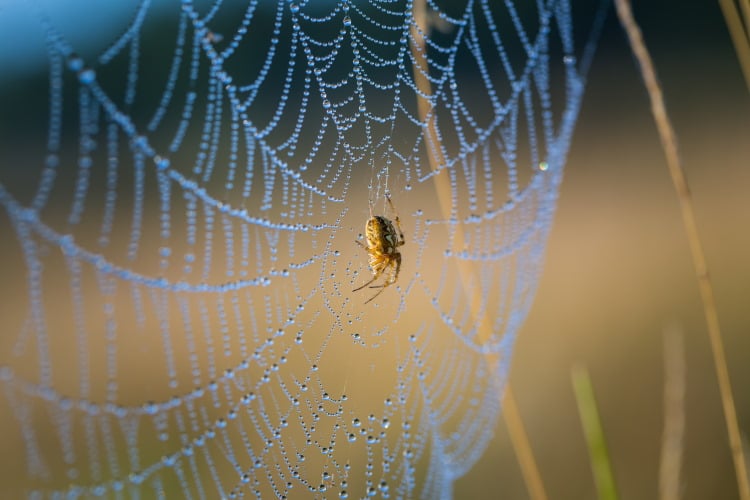
The more water that spider silk contains, the less brittle and the more elastic it is. The range is from about 30% to 300% elasticity – depending on the amount of water it contains. Thus we can see that changing the humidity of the environment the silk is spun in – and the length of time it exists in that environment before it is tested – will effect the results of the tests.
With all these things considered, we learn that the tensile strength of spider silk under normal laboratory conditions is slightly less than steel – if you compare it in terms of the thread’s diametre. But it is far greater than that of steel, if you compare it in terms of the weight of the thread.
Obviously spider silk is lighter per unit area than steel. When we make the comparison with Kevlar, we find that it is three times harder to break than spider silk – however spider silk is five times as elastic.
What Is Spider Silk Made Of?
OK, enough about the strength of spider silk. Where does it come from and what is it made of?
It is an unusual substance, in that it is quite acidic and is not attacked by bacteria or fungi – which is why cobwebs remain around for so long.
Silk is created as a proteinaceous liquid made of nanostrands from within special silk glands within the spider’s abdomen. The proteins have a molecular weight of 30,000 daltons (the units that the weights of atoms and molecules are measured in).
However when the silk is released from the spider’s spinnerets, it instantly solidifies and changes into a much larger molecule with a weight of between 200,000 and 300,000 daltons. Quite how this happens is not yet understood.
The proteins that make up dragline silk are secreted inside long, sac-like silk glands – from which they are funnelled as a watery solution into a long, looping duct. This duct leads to a small spigot, or nozzle, on the end of a spinneret.
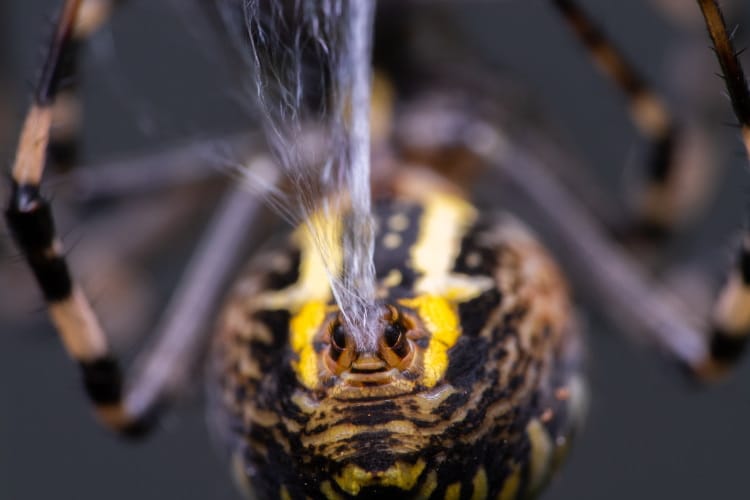
There are tens, or even hundreds, of these spigots – and therefore of their accompanying silk glands – for each spinneret; and most spiders have 6 (3 pairs) of spinnerets.
Examining the complex structure of silk, we see that its proteins come in two different forms: called α-chains and β-pleated sheets. The β-pleated sheets are about 10 nm by 15 nm and are interspersed in a matrix of the α-chains.
As I said above, spiders possess different glands that produce different silks. Scientists distinguish the following spider silk glands and silks. Not all spiders have all these glands – in fact the last two are only found in orb-web weavers.
Types Of Spider Silk Glands
| Silk Gland Name | Spinnerets Used | Type of Silk |
|---|---|---|
| Piriform | Anterior | Disk Attachment |
| Ampullate | Anterior/Median | Dragline and Web Frame |
| Aciniform | Median/Posterior | Wrapping silk, Sperm-web, Egg-cocoon (outer wall) |
| Tubuliform | Median/Posterior | Egg-cocoon |
| Aggregate | Posterior | Spiral parts of Sticky-web |
| Flagelliform | Posterior | Axial thread of Sticky-web |
The Cribellum Organ
As if this wasn’t enough, some spiders have an additional silk spinning organ called a cribellum.
The cribellum is situated in front of the three pairs of spinnerets and consists of between one and four plates, covered in spigots. The spider Stegodyphus pacificus has 40,000 spigots on its cribellum, but other species have much fewer.
Spiders that possess a cribellum are called ‘Cribellate’, as compared with the remaining spiders which are sometimes referred to as ‘Ecribellate’.
The silk is combed out of the spigots with a set of special hairs located on the 4th metatarsi called a ‘Calamistrum’. The silk produced by the cribellum is especially fine and is used to help entangle prey.
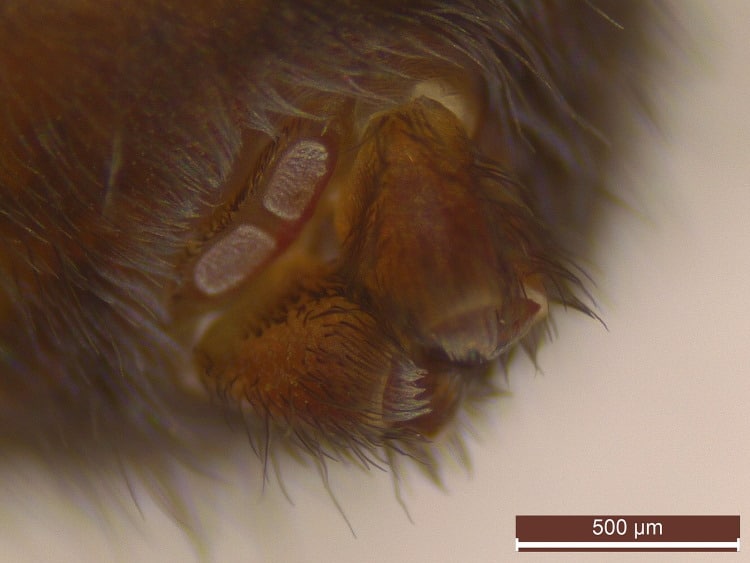
Spiders can control the thickness of a strand of silk using muscles and valves in the necks of the spigots; larger spiders for instance need thicker draglines. Most strands of spider web are only a few micrometres in diametre, for instance the dragline of an adult orb-web has a diametre of about 2µm. In comparison with this, hackle band silk is normally only 0.01µm to 0.02µm in diametre.
So now that we know something of what silk really is, lets have a look at how spiders actually use it. Naturally enough, different spiders use silk in different ways. However there are three nearly universal usages.
The first is the dragline, all spiders, as far as I know, use a dragline at sometime in their life.
In small species, the dragline is also a safety line that will catch them if they jump into space in order to avoid a predator. Many spiders do not use silk to make a catching web, but do use it to make themselves a nice cozy cocoon or cell to live in when they aren’t out hunting.
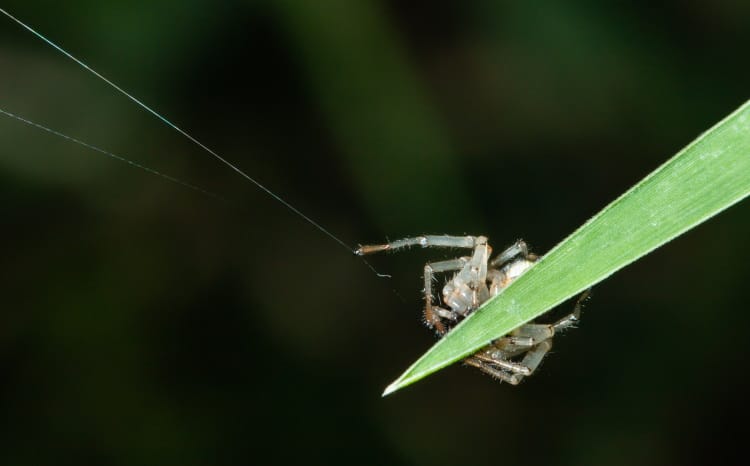
Such a neatly made hideaway helps them avoid predators and offers some protection from both excessive moisture and lack of moisture.
The other two uses are gender specific:
- Males spin a sperm web before mating, to allow them to charge their pedipalps;
- Females spin a web cocoon around their eggs; often it is composed of more than one kind of silk.
For more details on these uses please see Spider Reproduction.
Flying And Travelling
An unusual use of silk is flying. Small spiderlings stand ‘head down and abdomen up’ to release a strand of silk, which is caught by the breeze and lifted up. As the silk strand lengthens, it eventually creates enough lift to raise the spiderling; it turns, grabs the thread and away it goes.
This practice has become known as ‘balooning’.
Flying like this is a risky business, as there is no way the spider can control where it ends. Many must die as a result of landing in inappropriate places such as rivers and seas. However, for those that land somewhere more accessible, a new life is offered far away from all those brothers and sisters.
Spiders can travel huge distances by balooning like this and their ability to live without food and water for long periods of time undoubtedly help.
In May 1984, the first scientist to visit the island of Krakatoa (which had exploded violently 9 months earlier, exterminating all life on the island) reported that the only, and therefore first, animal he found on the island was a spider.
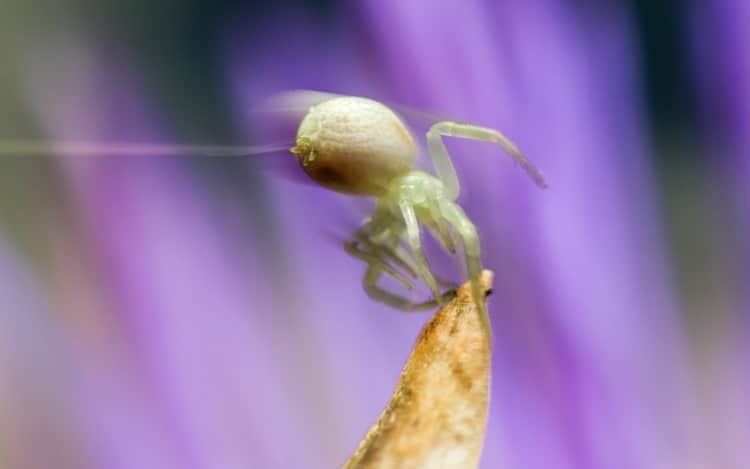
Krakatoa is 37 km (25 miles) from the nearest other land; however, spiders fly far further than this. Scientific research has recorded spiders over 4,500 metres (14,000 ft) above sea level and also in the middle of the ocean – 1,500 km (1,000 miles) from the nearest land.
In late summer over grasslands in temperate climates, you can experience huge numbers of these aeronautic spiders.
The silk they deposit across the landscape as they descend towards evenings (as the air cools and descends) can become very noticeable if you are out and about.
This is commonly called gossamer. In the past, huge falls of gossamer were well known. But while they can be experienced anywhere in the world on warm days, they appear to be less intense these days.
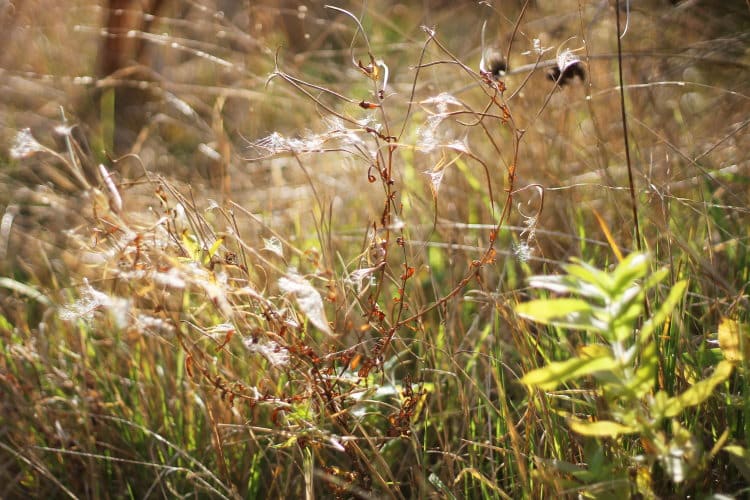
In France, gossamer is known as fils de la Vierge and in Germany as Marienfaden (both meaning ‘Our Lady’s threads’). Its presence is recorded in ancient literature, Pliny the Roman Historian and Encyclopaedist wrote what is now the earliest known reference to gossamer:
“in the year that L. Paulus and C. Marcellus were consuls, it rained wool“
And a few hundred years later Chaucer wrote:
“Sore wondren some on cause of thonder,
On ebb and floud, on gossomer, and mist.”
Proving that even then, people were amazed by the phenomenon of gossamer.
The Water Spider
The Water Spider, Argyroneta aquatica, lives in temperate Europe and is the only truly aquatic spider. It lives under the water, but still breathes air – and it has a wonderful way of getting enough.
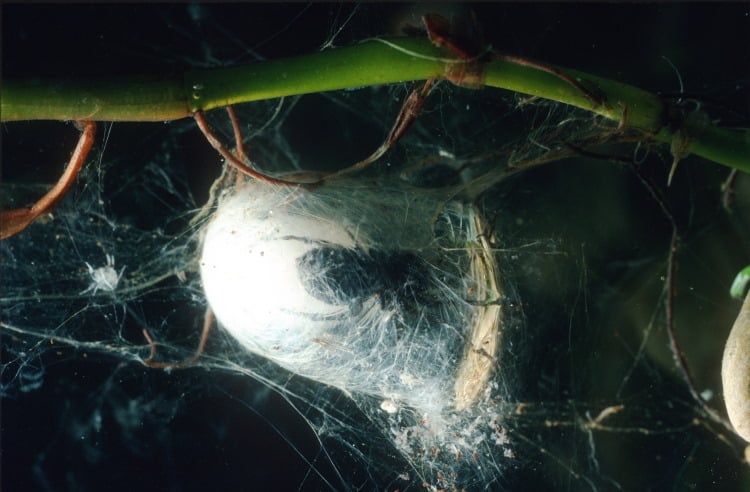
Using aquatic vegetation as an anchor, it builds from its silk a special dome shaped web under the water. Then, it brings bubbles of air (trapped in the hairs of its body) down from the surface and slowly fills the dome. This way it lives happily inside its dome, breathing air normally.
Catching Prey
The next two sets of spiders are highly unusual and I am unsure which I think is the most amazing. However both of them are fascinating, in the unusual methods they have developed to use their wondrous silk.
Bolas spiders (Mastophora sp.) are a small group of spiders in the family Araneidae.
This is a family that otherwise contains many Orb Web weavers. They hunt only at night and do so by dangling a thread of silk with a sticky blob on the end – and swinging this to entrap moths that come too near.
Thus they have been named after the weapon used by South American cowboys or gauchos.
It may seem improbable that this would catch them many moths, but the spiders have another trick that makes it work. They secrete a pheromone that is the same as that emitted by female ‘Armyworm’ moths (Spodoptera). This attracts the male moths, which are then easy for the spider to catch – as they just keep flying around until entangled in the bolas.
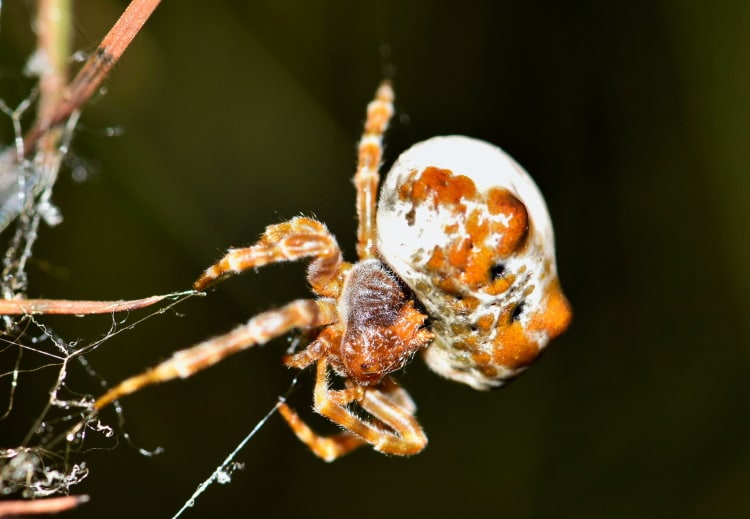
Taking this practice one step further, the spiders in the genus Caelenia in Australia do not even bother with a bolas. Instead they simply hang from a silk thread (presumably emitting a pheromone), legs and jaws at the ready – and the moths just fly straight to them. Catching dinner couldn’t be easier.
The second of my fabulously inventive spiders is Dinopis guatemalensis.
These spiders are commonly called Ogre Eyed spiders because they have huge eyes, which are extremely light sensitive. They hunt by night. They hunt by building a small platform of spider silk strands they can hang from – and then they make a small net.
They hold the net open and hang quietly, waiting for a passing insect. If an insect passes on the ground they will see it and throw the net over it – tugging it a few times to make sure the prey is well entangled. Then it is bitten, wrapped up a bit and eaten.
If however a fly comes past, the spider can detect the vibrations caused by its flight, and will throw its web net upwards to catch it. If successfully entangled, it too gets a bite and a wrap before being invited to diner.
Humans have used spider silk for a number of uses for a long time. The Roman encyclopaedist Pliny tells us that spider web is excellent for sealing wounds – and this is true as far as I know.
It has certainly been used for this purpose by many people since then. The answer may lie in both its immunity from microbial attack and its strange combination of softness and strength.
Many peoples have also used spider web silk to make clothes from – when woven it is both strong and light. Although the weaving of natural spider silk has never become a commercial proposition, it is still carried on by a few traditionalists in places such as Madagascar.
Spider silk is known to have been woven by primitive peoples to make simple bags, such as those once used to carry arrow heads by the natives of the New Hebrides – and as such must be a skill that has been practiced for a long time.
Spider silk was also regularly woven in more technologically advanced places, like India and China, where it was worn by the richest people only. In 1896, a Chinese delegation to Europe presented Queen Victoria with a spider silk gown.
And in 2009, an extremely rare and valuable cape made entirely from the silk of the Golden Orb Weaver was revealed. It is said to be the “only large piece of cloth made from natural spider silk existing in the world today.”
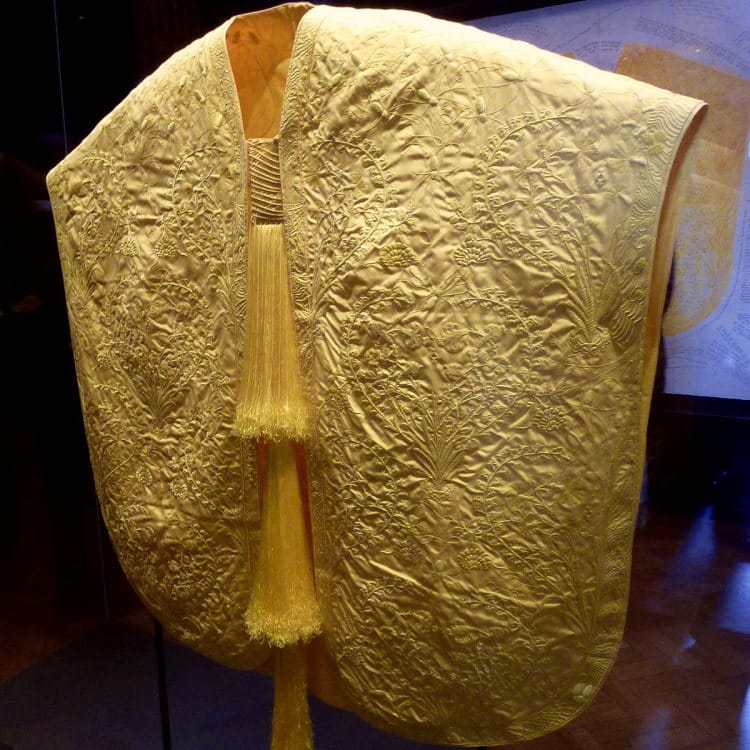
In the early nineteenth century a family of painters in Innesbruck made a name for themselves by painting on cloth made of spider silk. One of the interests of this is that the silk is so thin, the image can be seen equally clearly from both sides.
Historically, spider silk never had a chance to compete with silkworm silk because spiders are much more difficult to raise in large numbers, and because their silk lacks the lustre of silkworm silk.
But we should also mention that as of 2018, scientists were finally able to produce biosynthetic spider silk that is said to be on par with the real thing and showing great promise for industry.
Primitive peoples have long found ways of using spider webs, other than weaving them.
The literature of several European explorers contain references (sometimes quite detailed) to the use by various native peoples in the Austropacific area of spider webs to make nets – both for fishing and for catching butterflies.
These nets were either made from several webs collected, spread across the fork of a branch; or by bending and tying off a branch, to make a metre wide hoop, and then encouraging a spider (probably Nephila sp.) to spin a web within the hoop.
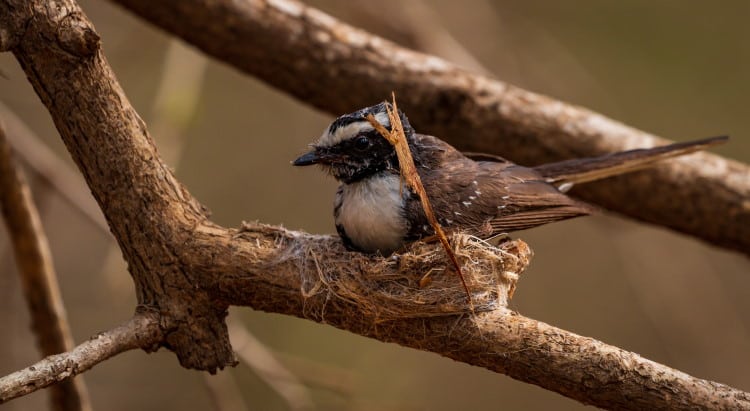
As a slight digression, before I finish this page, I must mention that man and spiders are not the only animals to find a use for spider silk.
Birds also like spider silk and it is in someways the perfect substance for binding up the materials that make a small bird’s nest.
In the Africa, the Americas, Asia Australia and Europe there are birds who not only enjoy spiders as a tasty meal, but who also rob them of their webs. Some Hummingbirds make ropes of spider silk to suspend their nests from and others build their nests almost entirely from spider silk.
Final Thoughts
Well I hope this page has helped you appreciate just how incredible the humble spider’s silk really is!
While you’re here, don’t forget to check out our article on the spider’s diet.
Amaurobius fenestralis (credit: Donald Hobern) image license: creative commons.


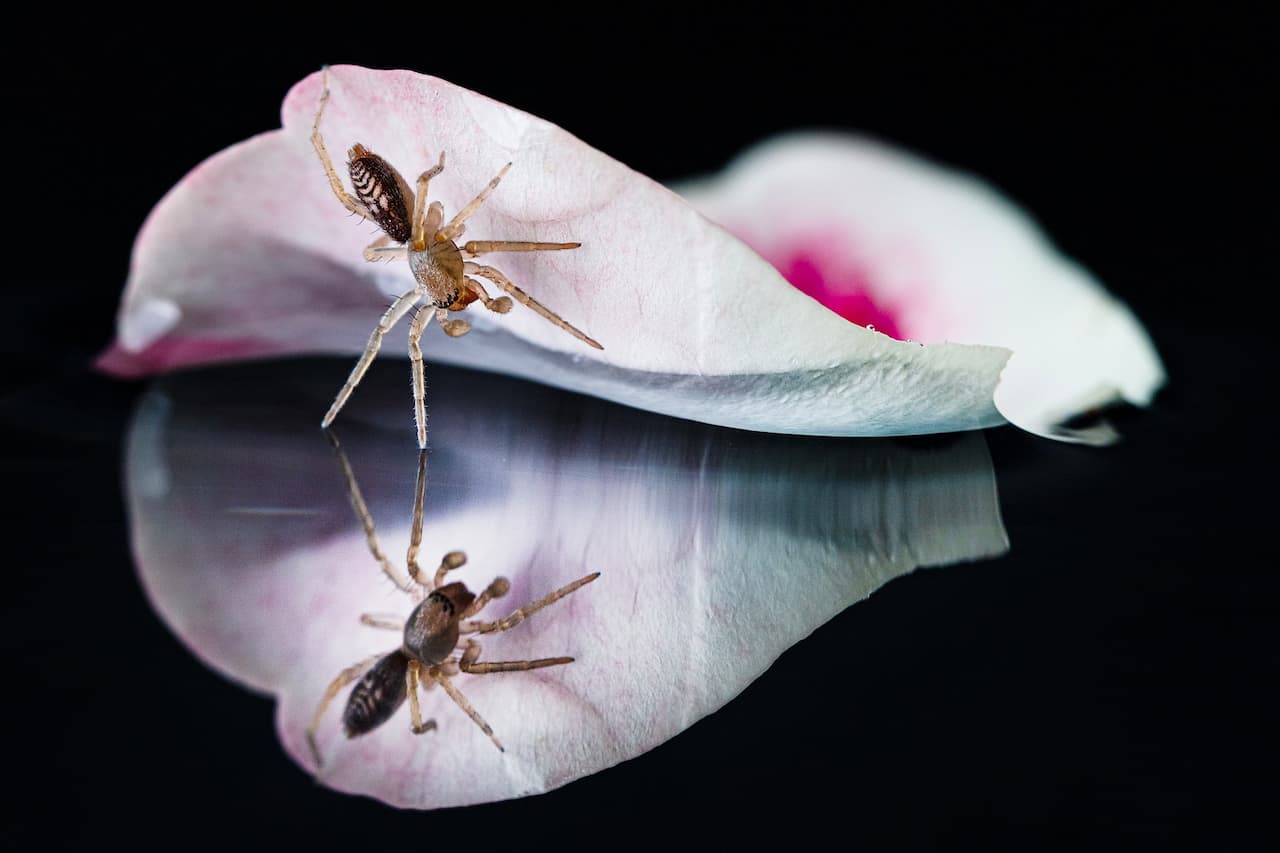

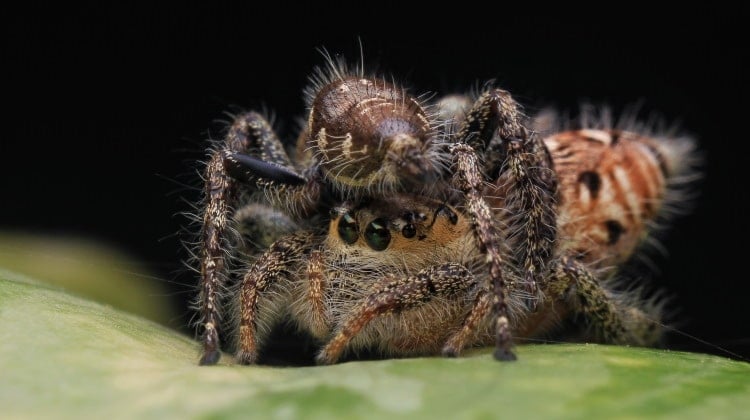
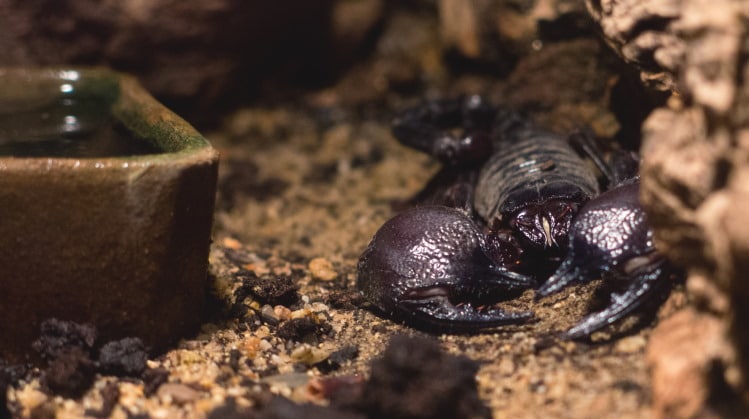
Thank you for taking the time to respond to this, I am not surprised there have been no studies on this so far. I would imagine you would need some very high resolution equipment to measure spider silk diameter! 😀
Hi there, my partner and I are curious about spider size and the diameter of the silk that is produced. Is there a relationship between the size of the spider and the thickness of the silk it produces? Does a larger spider produce thicker silk?
Hi Olly, that is a good question, and I expect the answer is yes, as judged from personal experience and theorized from biological practicalities, but I have never read anything about it.
Is there such a thing as spider silk fabric?
The short answer is yes. However it is not cheap or available in convenience stores yet. Try chasing up the leads on a Google search for “Spider Silk Fabric For Sale” – the following link is also interesting https://www.gearpatrol.com/tech/a466684/bolt-threads-synthetic-spider-silk/